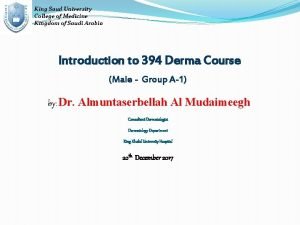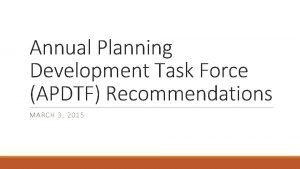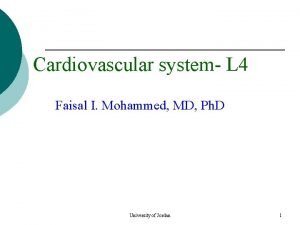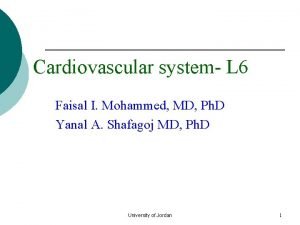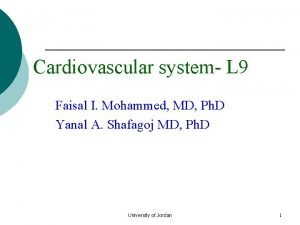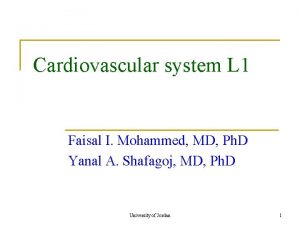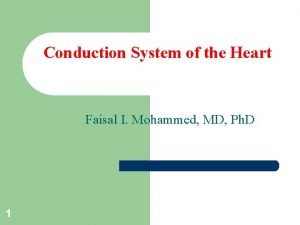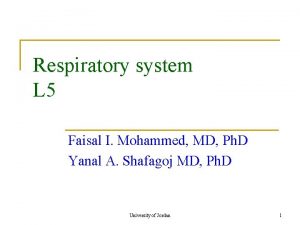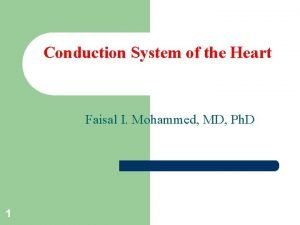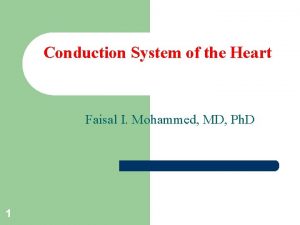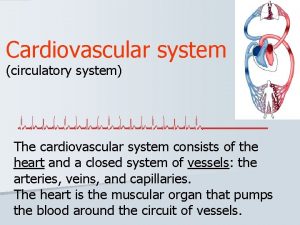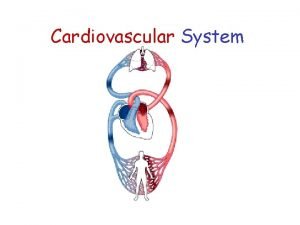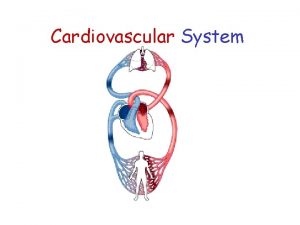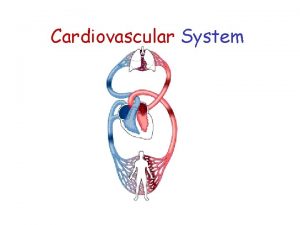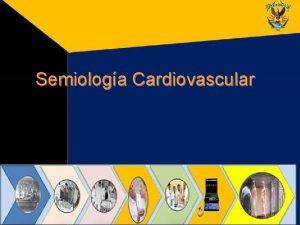Cardiovascular system L 5 Faisal I Mohammed MD



















- Slides: 19

Cardiovascular system- L 5 Faisal I. Mohammed, MD, Ph. D Yanal A. Shafagoj MD, Ph. D University of Jordan 1

The Circulatory System

Structure and function of blood vessels ¡ 5 main types l l Arteries – carry blood AWAY from the heart…their content might be oxygenated or deoxygenated blood Arterioles: redistribute blood to different tissues according to their needs Capillaries – site of exchange THE Venules Veins – carry blood back to the heart University of Jordan 3

Basic structure l 3 layers or tunics 1. 2. 3. l Tunica interna (intima) Tunica media Tunica externa Modifications account for 5 types of blood vessels and their structural/ functional differences University of Jordan 4

University of Jordan 5

Vessel Structure and Function

The Circulatory System is Composed of the Systemic and Cardiopulmonary Circulation ¡ Systemic Circulation Also called the peripheral circulation - Serves all tissues - Contains 84% of blood volume (64% in systemic veins, 14% in systemic arteries and 7% systemic capillaries) -Pulmonary Circulation contain 9% of blood volume - Heart chambers contain 7%

Blood Distribution v Largest portion of blood at rest is in systemic veins and venules. Veins are called capacitance vessels ¡Blood reservoir University of Jordan 8

Pressure Changes through the circulation

Mean Arterial Pressure (MAP) 0. 0 0. 3 0. 8 MAP= 1/3 systolic pressure + 2/3 Diastolic pressure MAP= Diastolic Pressure +1/3 Pulse Pressure t 1 t 2

Blood Pressure l l l Contraction of ventricles generates blood pressure Systolic BP – highest pressure attained in arteries during systole. Pulsatile in the arteries Diastolic BP – lowest arterial pressure during diastole Pressure falls progressively with distance from left ventricle Blood pressure also depends on total volume of blood The largest drop of BP in the circulation is at the arterioles (resistance vessels). Loss of pulsation after this point University of Jordan 11

Vascular resistance l l Opposition to blood flow due to friction between blood and walls of blood vessels Depends on 1. Size of lumen – vasoconstriction makes lumen smaller meaning greater resistance 2. Blood viscosity – ratio of RBCs to plasma and protein concentration, higher viscosity means higher resistance 3. Total blood vessel length – resistance directly proportional to length of vessel l 400 miles of additional blood vessels for each Kg of fat University of Jordan 12

Hemodynamic laws ¡ Poiseuille’s law Flow = Driving force/Resistance = ∆P/R…. Ohm’s law R = 8 L / r 4…. Poiseuille’s law ∆P = change in pressure r = radius of the vessel (eta) = viscosity L = length of the vessel

Effect of Vessel Diameter on Blood Flow P= 100 mm Hg

Velocity of blood flow l l l l Velocity=Flow/Area Speed or velocity in cm/sec in inversely related to cross-sectional area Velocity is slowest where total cross sectional area is greatest…. in the capillaries Blood flow becomes slower farther from the heart Slowest in capillaries Aids in exchange Circulation time – time required for a drop of blood to pass from right atrium, through pulmonary and systemic circulation and back to right atrium ¡ Normally 1 minute at rest University of Jordan 15

Velocity (V ) is proportionate to flow (F) divided by cross sectional area of the blood vessel (A): ¡ F=A*V ¡ ¡ V=F/A So blood flow is fastest in aorta and slowest in capillaries ?

Relationship between Velocity of Blood Flow and Total Cross-sectioned area in Different Types of Blood Vessels University of Jordan 17

BLOOD FLOW ¡ Blood flow or ‘‘F‘‘ = Blood flow means simply the quantity of blood that passes a given point in the circulation in a given period of time (m. L/Sec).

University of Jordan 19
 Epcardium
Epcardium Dr ahmad faisal
Dr ahmad faisal Uch sharif mazar
Uch sharif mazar Faisal fairag kfupm
Faisal fairag kfupm King faisal university college of medicine
King faisal university college of medicine Faisal jaswal
Faisal jaswal Faisal ali mousa
Faisal ali mousa Behavioral adaptation of a tiger
Behavioral adaptation of a tiger Said faisal aha centre
Said faisal aha centre Faisal hd
Faisal hd Blood vesel
Blood vesel What makes up the circulatory system
What makes up the circulatory system Pithed rat model
Pithed rat model Its tubular dude
Its tubular dude Structure of blood vessels
Structure of blood vessels Chapter 5 the cardiovascular system
Chapter 5 the cardiovascular system Chapter 11 the cardiovascular system figure 11-3
Chapter 11 the cardiovascular system figure 11-3 Figure 11-8 arteries
Figure 11-8 arteries Lesson 11 cardiovascular system
Lesson 11 cardiovascular system Lesson 11 cardiovascular system
Lesson 11 cardiovascular system




